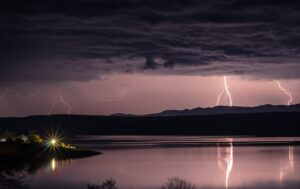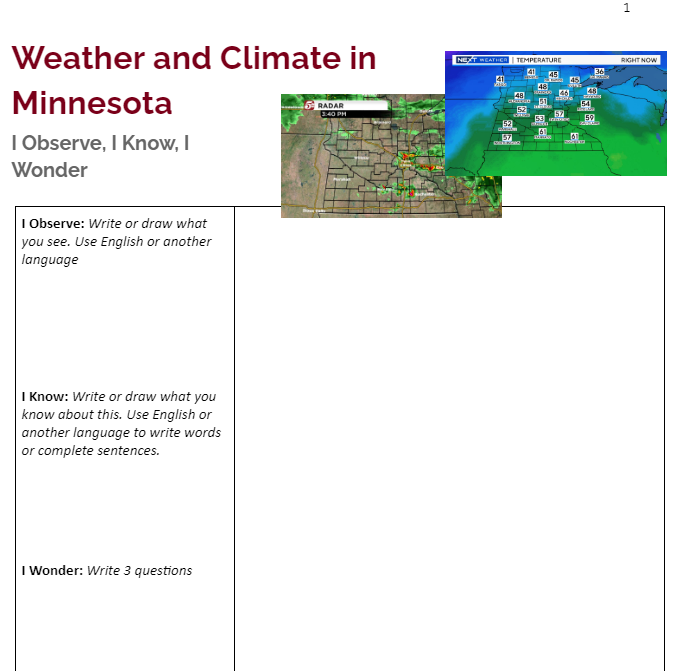- MN ABE Connect
- Archive
- Embedded Teaching: Application in a Science Lesson (Part 2)
 February 9, 2024
February 9, 2024
Embedded Teaching: Application in a Science Lesson (Part 2)
Lucas Rapisarda, Program DirectorPart 1 of this article discussed the benefits of embedding language learning into explicit science instruction (for a more in-depth review, check out Part 1!) In this newsletter, we will take a closer look at a lesson developed by Nature for New Minnesotans for our Climate and Seasons module that promotes the development of scientific vocabulary through learning about the climate and seasons of Minnesota.
In the first lesson, students are asked to make a clear distinction between the terms ‘climate’ and ‘weather’. At first glance, these two words appear to have the same general meaning and are often used interchangeably in social registers when talking about outdoor conditions. However, the two words are used quite differently when discussing climatology, and the difference between the two is very important when understanding the impact of climate change on weather.
 Weather indicates a short-term change in the temperature, precipitation, and wind of a place and can be different from day to day.
Weather indicates a short-term change in the temperature, precipitation, and wind of a place and can be different from day to day.
In contrast, climate indicates the typical or average weather conditions in a particular place or region. When it snows in July, we can observe that the weather is acting strange, in large part because we know the climate of Minnesota historically does not involve snow in summer! In other words, we often interpret the weather through a lens of climate, which involves large temperature and precipitation datasets maintained over time. We also interpret weather patterns in the context of anthropogenic climate change, an environmental issue impacting all Minnesotans.
Embedded teaching via multiple mediums
 The lesson begins with a series of videos that first depict a timelapse of a year in Minnesota, followed by a daylong timelapse depicting a summer thunderstorm. Next, students are shown images of weather and climate maps. Following an embedded teaching mindset, definitions of climate and weather are not introduced prior to viewing each of these artifacts. Instead, students complete an Observe, Know, Wonder activity, and also ‘turn and talk’ to their neighbors about what they have observed in the videos and images.
The lesson begins with a series of videos that first depict a timelapse of a year in Minnesota, followed by a daylong timelapse depicting a summer thunderstorm. Next, students are shown images of weather and climate maps. Following an embedded teaching mindset, definitions of climate and weather are not introduced prior to viewing each of these artifacts. Instead, students complete an Observe, Know, Wonder activity, and also ‘turn and talk’ to their neighbors about what they have observed in the videos and images.
The use of multiple mediums (visual, aural, written) to introduce scientific concepts is a key component of embedded teaching. This activity allows students to ‘make sense’ of the multiple media sources without the challenge of integrating academic vocabulary into their observations, and also allows the instructor to gauge students’ initial understanding of the concept without any pre-teaching. Often, the words ‘weather’ and ‘climate’ automatically arise, as well as words such as ‘over time’ and ‘short vs. long-term’.
By grounding the activity in students’ own understanding, it gives students agency to discuss weather and climate using a language register that they are comfortable with. Additionally, it provides the instructor with opportunities to discuss and model the use of the terms ‘climate and weather’ in both social and more academic registers.
Introducing the academic terms
 Once the class has reached a general consensus of the similarities and differences between the two types of maps, as well as the videos, the instructor can introduce the academic terms of ‘climate‘ and ‘weather’. The lesson then transitions into more intentional vocabulary learning, which includes a reading discussing the difference between weather and climate, followed by reading comprehension questions. It also includes an optional extension that focuses on the word ‘average’, which is used in both social and academic registers to describe the climate of a place.
Once the class has reached a general consensus of the similarities and differences between the two types of maps, as well as the videos, the instructor can introduce the academic terms of ‘climate‘ and ‘weather’. The lesson then transitions into more intentional vocabulary learning, which includes a reading discussing the difference between weather and climate, followed by reading comprehension questions. It also includes an optional extension that focuses on the word ‘average’, which is used in both social and academic registers to describe the climate of a place.
In the final stage of the lesson, students revisit the videos and images from the beginning of the lesson and label them as examples of the ‘weather of Minnesota’ or ‘climate of Minnesota’, creating opportunities for students to move their use of the vocabulary into more academic registers.
Lesson summary
In summary, this lesson seeks to introduce students to the scientific concepts of weather and climate through language instruction and ‘sensemaking’ activities. By gaining a deeper understanding of these two concepts, students will be able to grapple with more complex environmental issues such as climate change in later lessons in the module.
Check out the Climate and Seasons of Minnesota module, as well as additional resources, on the Nature for New Minnesotans website!
Newsletter Signup
Get MN ABE Connect—the official source for ABE events, activities, and resources!
Sign UpArticle Categories
- ABE Foundations/Staff Onboarding
- ACES/Transitions
- Adult Career Pathways
- Assessment
- CCR Standards
- Citizenship
- COVID-19
- Cultural Competency
- Digital Literacy/Northstar
- Disabilities
- Distance Learning/Education
- ELA
- Equity/Inclusion
- ESL
- HSE/Adult Diploma
- Listening
- Math/Numeracy
- Mental Health
- Minnesota ABE
- One-Room Schoolhouse/Multilevel
- Professional Development
- Program Management
- Reading
- Remote Instruction
- Science
- Social Studies
- Speaking/Conversation
- Support Services
- Teaching Strategies
- Technology
- Uncategorized
- Volunteers/Tutors
- Writing